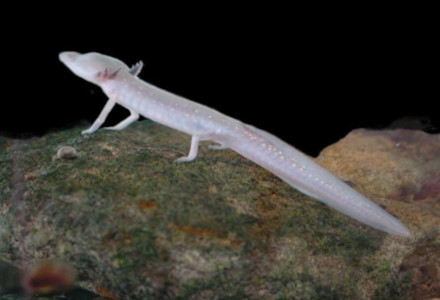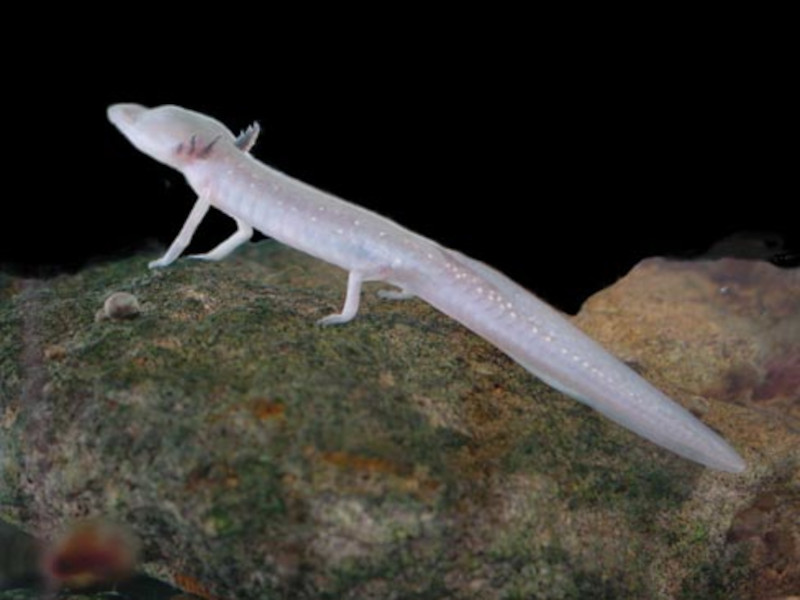Texas Blind Salamander Facts
- This distinctive-looking amphibian most frequently goes by the informative common name of the Texas Blind Salamander, and for good reasons. Yet it also has another name that, while still hard to pronounce, rolls off the tongue with comparative ease.
- That’s because, like all species, it also has a formal, scientific name. In most instances, though, this term’s somewhat difficult for non-professionals to pronounce. In the case of this particular fascinating species, though, that’s a relatively simple alternate name.
- This holds true due to the specific fact that, in the halls of science, it bears the official name of the Eurycea rathbuni. This marvel of Nature further received this moniker as a result of the work of the Norwegian-born American zoologist, Leonhard Hess Stejneger.
- He accomplished the first formal recognition of the creature as a separate and distinct species in the year 1896. Uniquely, it also has an alternate scientific name that he assigned it. Though no longer used, it once bore the name of the Typhlomolge rathbuni.
- Unfortunately for those who appreciate the wonders of Nature, it now finds itself facing several threats to its continued existence. Due to the combination of factors, the IUCN currently lists the amphibian as Vulnerable on its Red List of Threatened Species.
- The nature and extent of its own natural range renders the Texas Blind Salamander extremely vulnerable to habitat degradation or loss. The ongoing threat of climate change, however, no doubt also poses a dire threat to its existence, like most species.
- Efforts are being made to preserve this product of countless ages of evolution, though. That’s because, in 2013, the USFWS approved a specific habitat conservation plan. This aims at protecting its local environment, thereby reducing stresses on the species.
Related Articles
Texas Blind Salamander Physical Description
The Texas Blind Salamander merits appreciation for its physical attributes in several ways, to be certain. The most notable among these, however, is no doubt its eyes. Or rather, the lack of them. Technically, though, the awesome animal does actually have eyes.
These organs remain vestigial, though, and primitive in their general structure. Furthermore, they also lie under the skin, completely covered, and are thus nonfunctional. Given the habitat of the animal, though, such organs would be completely superfluous.
Unlike many of its related species, this creature displays no noticeable degree of the physiological characteristic of sexual dimorphism. It’s therefore quite difficult for an untrained individual to tell the genders apart, as they remain visually indistinguishable.
Both genders of this remarkable animal, in fact, actually remain relatively small in terms of size. That’s because mature specimens attain a maximum known body length of roughly 5.5 in (14 cm). Most individuals, however, reach a size closer to 3.5 in (9 cm).
The body shape of both sexes develops as highly elongated, again, like most of its many kindred. It also develops a relatively broad, flat head and snout. The flesh-covered eyes literally comprise nothing more than two small black dots under the skin.
Due to its environment, the Texas Blind Salamander has no need for pigmentation in its skin. It therefore presents a pasty, off-white color. The gills protrude from the throat, and represent the sole exception to this pattern, being bright red in color.
- Kingdom: Animalia
- Phylum: Chordata
- Class: Amphibia
- Order: Urodela
- Family: Plethodontidae
- Genus: Eurycea
- Species: E. rathbuni
Texas Blind Salamander Distribution, Habitat, and Ecology
Obviously, the very name of this distinctive creature holds clues to its range of distribution. Unfortunately, both for it, and those of us who value Nature, it evolved as native to a highly restricted range of the world. It also appears that it never spread beyond that range.
This fascinating amphibian apparently evolved as endemic to a very small portion of what now constitutes the country of the United States, in North America. More specifically, the intriguing animal appears to only live within the boundaries of the state of Texas.
Even within that already restrictive range, the creature remains limited to a very tiny, and highly specific, zone of habitation. That’s due to the fact that specimens inhabit a total of only seven known locations, all located in a single county of the state; Hays county.
Amazingly, within that territory, it only makes its home in very specific environments. These consist solely of water-filled caves, in the Purgatory Creek System, and along the San Marcos Fault. This therefore places its range solely in the vicinity of the city of San Marcos.
Like its many relatives, the Texas Blind Salamander feeds as a carnivore. It also feeds opportunistically. Due to the nature of its habitat, it consumes various small prey, including snails, blind shrimp, and other tiny crustaceans, most of which flow into its area in the water.
Due to the extremes of its specific natural environment, researchers do not know a great deal about its life cycle. It’s believed, however, that the species breeds throughout the year. Its lifespan in the wild remains unknown, but captive specimens live up to 10 years.
Species Sharing Its Range
Check out our other articles on 4 Breathtaking Bays and Inlets, Platypus, Lake Hillier, Nepenthes pervillei, Zebra Shark, Giant Wood Moth, California red-sided garter snake


